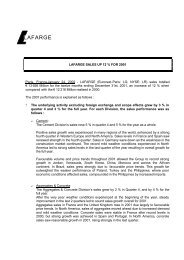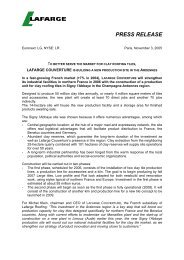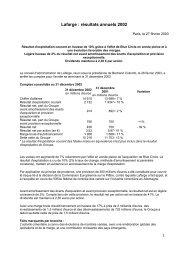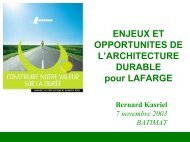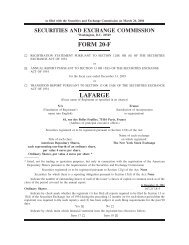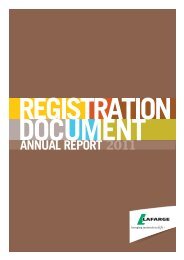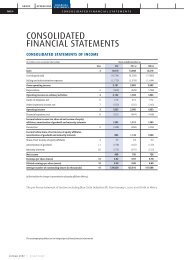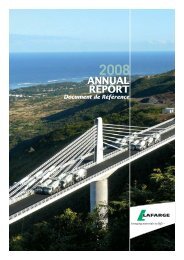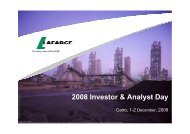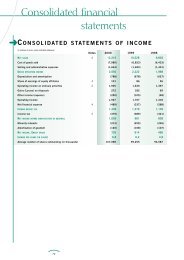2005 Sustainability Report - Lafarge
2005 Sustainability Report - Lafarge
2005 Sustainability Report - Lafarge
You also want an ePaper? Increase the reach of your titles
YUMPU automatically turns print PDFs into web optimized ePapers that Google loves.
Exerting a responsible<br />
influence<br />
Public positions<br />
of the <strong>Lafarge</strong> Group<br />
in <strong>2005</strong><br />
IMPLEMENTATION OF THE CO2 EMISSIONS TRADING SCHEME<br />
Having taken the voluntary initiative in 2000 to cut its CO2 emissions, <strong>Lafarge</strong> supports in principle<br />
any system contributing to a reduction in greenhouse gases and thus the EU-ETS 1 mechanism.<br />
The Group believes that the current CO2 emission quota trading system could be more effective<br />
and more competitive if it took into account the following factors:<br />
• The allocation of emission quotas should be based on performance standards allowing past efforts<br />
to be taken into account rather than on historic emissions, which put less effective installations at an<br />
advantage and do not give recognition to initiatives taken in recent years. The competitive gap created<br />
by the value of CO2 in the EU-ETS with the rest of the world is a very grave concern for <strong>Lafarge</strong>'s<br />
business activities, which are vulnerable to imports.<br />
• Auctions should be banned, because the proceeds are not systematically invested in new emissionlowering<br />
technologies.<br />
• <strong>Lafarge</strong> believes that combustible waste should be regarded as neutral in terms of CO2 emissions<br />
because its re-use in a cement plant helps to reduce overall emissions.<br />
• <strong>Lafarge</strong> does not want any restriction to be placed on the use of the Kyoto flexibility mechanisms.<br />
• The Group supports the “domestic project” concept enabling an industry player to obtain CO2 credits<br />
when it invests in a project to reduce greenhouse gas emissions in its national territory.<br />
1 | EU – ETS : European Union – Emissions Trading Scheme.<br />
PAGE 14 | <strong>2005</strong> SUSTAINABILITY REPORT | LAFARGE<br />
In the Philippines, <strong>Lafarge</strong><br />
uses rice husks as alternative fuel<br />
up to 35% substitution.<br />
The Stern rests on a gravel bed<br />
at the rehabilitated quarry in Barbey, France.<br />
BIODIVERSITY<br />
Quarry operation represents only one stage<br />
in the life of soil. <strong>Lafarge</strong> thus believes<br />
that its activities can be incorporated<br />
within the logic of the Natura 2000 EU<br />
project (network designed to protect<br />
threatened and/or outstanding habitats<br />
and species throughout Europe).<br />
WASTE RECOVERY<br />
(INDUSTRIAL ECOLOGY)<br />
<strong>Lafarge</strong> commits to minimizing<br />
its consumption of fossil fuels and<br />
non-renewable raw material: by-products<br />
and waste are alternatives that <strong>Lafarge</strong><br />
favors to limit the environmental impacts.<br />
<strong>Lafarge</strong> therefore advocates for regulations<br />
in favor of these practices and commits<br />
to controlling the environmental<br />
and health impacts of using these<br />
by-products and wastes.




